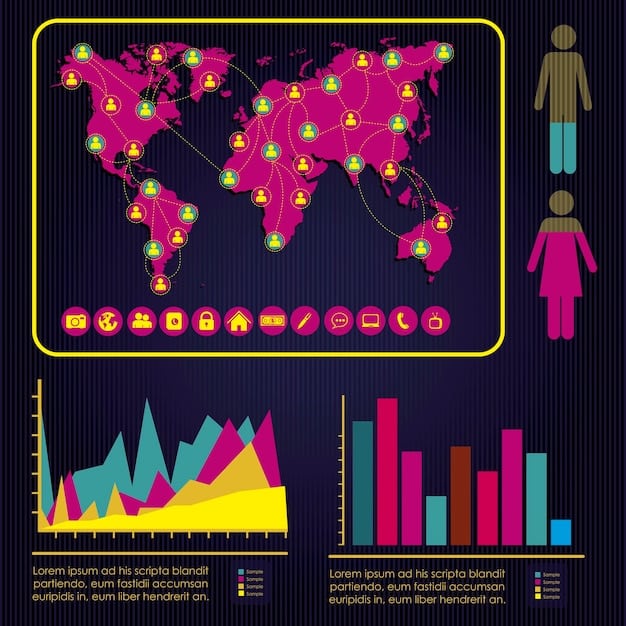US Tech Companies Face Mounting Pressure to Improve Diversity and Inclusion

Advertisements
US tech companies are under increasing scrutiny to enhance their diversity and inclusion (D&I) initiatives, a critical movement driven by both internal and external pressures aiming to foster more equitable and representative workplaces within a predominantly homogeneous industry.
Advertisements
The tech industry, a global powerhouse of innovation and economic growth, has long grappled with a significant challenge: a glaring lack of diversity and inclusion. From Silicon Valley giants to burgeoning startups, the faces behind the screens often tell a homogeneous story. However, this narrative is rapidly shifting as US tech companies face growing pressure to improve diversity and inclusion, prompting a much-needed reckoning and a push towards more equitable landscapes.
The Persistent Diversity Gap in Tech
Despite years of discourse and myriad initiatives, the technology sector continues to exhibit stark disparities in representation. This diversity gap is not merely a matter of optics; it reflects systemic issues that impede innovation, foster exclusivity, and ultimately undermine the financial and social potential of these companies. Understanding the entrenched nature of this problem is the first step toward effective remediation.
Advertisements
Historically, the tech workforce has been overwhelmingly white and male, particularly in leadership and technical roles. While some progress has been made, particularly in entry-level positions, the senior ranks remain largely unchanged. This homogeneity can lead to a narrow range of perspectives, hindering problem-solving and limiting the industry’s ability to cater to a global, diverse user base.
Examining the Data: Where the Gaps Lie
Recent reports consistently highlight specific areas where diversity is most lacking. These include:
- Gender Representation: Women remain significantly underrepresented in technical roles and at executive levels, facing unique challenges related to bias and career progression.
- Racial and Ethnic Diversity: Black, Hispanic, and Indigenous professionals are often marginalized, particularly in engineering and product development teams, leading to systemic underrepresentation.
- Leadership Roles: Diversity metrics tend to worsen at higher echelons of management, indicating a “leaky pipeline” where diverse talent struggles to advance.
- Accessibility for People with Disabilities: The tech industry has been slow to fully embrace and accommodate individuals with disabilities, both in terms of employment and user experience.
The implications of this persistent gap are far-reaching, affecting everything from product design to company culture. Addressing it requires more than just good intentions; it demands proactive, data-driven strategies and a commitment to dismantling long-standing barriers.
Mounting External Pressures for Change
The intensifying scrutiny on tech companies is not an isolated phenomenon. It stems from a confluence of external forces, including evolving societal expectations, investor demands, and governmental oversight. These pressures are compelling companies to move beyond superficial commitments and implement meaningful, measurable changes to their D&I frameworks.
Stakeholders across the board are increasingly vocal about the need for tech to reflect the diversity of the world it serves. This collective voice is proving to be a powerful catalyst for transformation, pushing D&I from a “nice-to-have” to a strategic imperative.
Shareholder Activism and ESG Metrics
Investors are increasingly recognizing the correlation between robust diversity practices and long-term financial performance. This has led to a surge in shareholder activism, with investment firms and proxy advisors pushing for greater transparency and accountability in D&I reporting. Environmental, Social, and Governance (ESG) metrics now prominently feature diversity as a key indicator of corporate health and sustainability.
Companies are finding that a strong D&I posture can attract and retain top talent, enhance brand reputation, and even mitigate risks associated with social unrest or legal challenges. Conversely, poor D&I performance can lead to reputation damage, difficulty attracting a diverse customer base, and even legal battles.
Societal Demands and Public Scrutiny
The broader societal landscape, particularly in the wake of global conversations on social justice, has significantly amplified calls for diversity. Tech companies, given their vast influence on daily life, are no longer exempt from these demands. Consumers, advocacy groups, and the media are holding these firms to higher standards, often leveraging social media to highlight injustices or celebrate progress.
Negative publicity surrounding a lack of diversity can severely impact a company’s public image and consumer trust. This constant public scrutiny serves as a powerful deterrent against inaction and encourages companies to proactively address their internal demographics to align with societal values.

Internal Catalysts: Employee Activism and Innovation
The push for diversity and inclusion is not just an external imperative; it is also profoundly driven by internal forces. Employees, particularly those from underrepresented groups, are increasingly advocating for more equitable workplaces. This internal activism, coupled with a growing understanding of D&I’s impact on innovation, is reshaping corporate priorities within the tech sector.
A groundswell of grassroots movements within companies demonstrates that employees are no longer content with passive statements about D&I. They demand tangible action and genuine cultural shifts.
The Power of Employee Voices
Employee resource groups (ERGs), diversity councils, and internal petitions are becoming potent tools for change. Employees are leveraging these platforms to share their experiences, highlight systemic biases, and propose solutions. Their firsthand accounts of discrimination, microaggressions, and lack of opportunity provide invaluable qualitative data that often motivates leadership to act.
- Demanding Transparency: Employees are pushing for companies to release detailed diversity data, beyond just overall percentages, to show representation across roles and levels.
- Advocating for Inclusivity: Calls for more inclusive policies, from parental leave to flexible work arrangements, are becoming more frequent.
- Highlighting Bias: Employees are actively pointing out instances of unconscious bias in hiring, promotion, and performance reviews.
Leaders who listen to and empower these voices often find that employee-driven initiatives are more authentic, effective, and sustainable than top-down mandates.
Diversity as an Innovation Driver
Beyond moral obligations, tech companies are realizing that diversity is a critical engine for innovation. Teams composed of individuals with varied backgrounds, experiences, and perspectives are more likely to generate creative solutions, identify new market opportunities, and understand diverse customer needs. Homogeneous teams, by contrast, risk groupthink and a limited scope of understanding.
This understanding is shifting D&I away from being solely a compliance or HR function to a strategic business imperative, directly linked to a company’s ability to innovate and compete in a global market.
Strategies for Building More Inclusive Tech Environments
Addressing the deep-seated issues surrounding diversity and inclusion in tech requires a multi-faceted approach. Companies are implementing a range of strategies, from overhauling hiring practices to fostering inclusive cultures, to ensure that their D&I efforts yield measurable and sustainable results. These initiatives move beyond mere quotas, focusing on systemic change.
The most effective strategies are comprehensive, involving all levels of the organization and integrating D&I into the core business strategy.
Reimagining Talent Acquisition and Retention
A primary focus for many tech companies is transforming how they attract, recruit, and retain diverse talent. This involves:
- De-biasing Hiring Processes: Implementing blind resume reviews, diverse interview panels, and objective assessment criteria to minimize unconscious bias.
- Expanding Candidate Pools: Actively recruiting from Historically Black Colleges and Universities (HBCUs), Hispanic-Serving Institutions (HSIs), and organizations dedicated to diverse talent.
- Inclusive Onboarding: Ensuring new hires from diverse backgrounds feel welcomed, supported, and integrated into the company culture from day one.
- Mentorship and Sponsorship Programs: Providing structured programs to support the career development and advancement of underrepresented employees.
Retention is as crucial as recruitment. Companies must create environments where diverse employees feel valued, heard, and see clear paths for career growth to prevent a “revolving door” phenomenon.
Fostering a Culture of Belonging
Beyond representation, true inclusion means cultivating an environment where everyone feels they belong and can thrive. This involves:
- Leadership Buy-in and Accountability: D&I must be championed from the top, with leaders setting clear expectations and being held accountable for progress.
- Inclusive Communication: Promoting respectful dialogue, active listening, and addressing microaggressions promptly and effectively.
- Psychological Safety: Creating a safe space where employees feel comfortable expressing ideas, admitting mistakes, and raising concerns without fear of retribution.
- Unconscious Bias Training (Effective): Moving beyond one-off training to sustained, integrated learning programs that encourage self-awareness and behavioural change.
A truly inclusive culture acknowledges individual differences, leverages them as strengths, and ensures that all voices contribute to the company’s success and evolution.
The Role of Data and Accountability
Meaningful progress in diversity and inclusion cannot be achieved without robust data collection, transparent reporting, and clear accountability mechanisms. Tech companies are increasingly adopting data-driven approaches to understand their current state, track progress, and identify areas requiring further intervention. This analytical rigor transforms D&I from an abstract concept into a measurable business objective.
Without data, D&I initiatives often operate in a vacuum, making it difficult to assess their effectiveness or justify continued investment. The move towards data-centric D&I strategies is a critical step in the industry’s evolution.
Measuring What Matters: Metrics and Benchmarks
Companies are moving beyond simple headcounts to analyze a wider array of diversity metrics, including:
- Representation at all Levels: Tracking demographic data across different roles, teams, and management tiers.
- Attrition Rates: Analyzing employee turnover rates by demographic group to identify potential issues with retention or inclusion.
- Promotion Rates: Examining promotion rates across different demographics to identify potential biases in career advancement.
- Pay Equity: Conducting regular audits to ensure fair compensation across demographic groups for similar work.
- Inclusion Survey Scores: Using employee surveys to gauge feelings of belonging, psychological safety, and perceptions of fairness within the workplace.
Establishing clear benchmarks and regularly reporting on these metrics, both internally and externally, fosters transparency and allows for continuous improvement.
Accountability Frameworks
For D&I efforts to be sustained, accountability must be embedded throughout the organization. This involves:
- Leadership Scorecards: Tying D&I goals to performance reviews and compensation for managers and executives.
- Dedicated D&I Teams: Establishing dedicated teams with the resources and authority to drive D&I initiatives.
- Transparent Goal Setting: Publicly committing to specific, measurable, achievable, relevant, and time-bound (SMART) D&I goals.
- External Audits and Reporting: Engaging independent third parties to assess D&I progress and report findings to stakeholders.
Accountability ensures that D&I is not merely a fleeting trend but a core component of business operations and success, requiring active oversight and management like any other critical strategic objective.

Challenges and Future Outlook
While significant pressure is catalyzing change, the journey towards truly diverse and inclusive tech environments is fraught with challenges. Resistance to change, the complexities of systemic bias, and the sheer scale of the industry mean that progress, though accelerating, will still require sustained effort. However, the future outlook suggests a continued, albeit challenging, trajectory toward greater equity.
Overcoming these hurdles will necessitate ongoing commitment, innovative solutions, and a willingness to confront uncomfortable truths within organizations.
Overcoming Resistance and Systemic Challenges
One of the primary challenges is overcoming ingrained resistance to change, often stemming from unconscious biases or a lack of understanding about the benefits of D&I. Systemic issues, such as pipeline problems in education or societal prejudices, also contribute to the complexity.
Companies must address these root causes, pushing beyond surface-level fixes to dismantle deeply embedded structures that perpetuate inequality. This involves educating employees, challenging long-held assumptions, and fostering environments where difficult conversations about privilege and power can occur constructively.
The Evolving Landscape of D&I
The definition of diversity itself is continually expanding to include neurodiversity, socioeconomic background, veteran status, and other dimensions. Tech companies are recognizing that a truly inclusive workplace embraces the full spectrum of human experience.
The focus is also shifting from merely “fitting in” to “belonging,” emphasizing psychological safety and the ability for individuals to bring their whole selves to work. This evolving understanding means D&I strategies must remain agile and adaptable, continuously learning from best practices and adapting to new insights.
Predictions for Progress
Looking ahead, several trends are likely to shape the future of D&I in tech:
- Increased Regulatory Scrutiny: Governments may impose more stringent reporting requirements or even quotas if voluntary progress is insufficient.
- AI and Bias: Greater attention will be paid to the potential for AI and algorithmic systems to perpetuate or amplify existing biases, and the need for diverse teams in their development.
- Globalization of D&I: As tech companies operate globally, D&I strategies will need to adapt to diverse cultural contexts and legal frameworks.
- Intersectional Approaches: A deeper understanding and integration of intersectionality, recognizing how different aspects of identity combine to create unique experiences of discrimination or privilege.
While the path is long and complex, the increasing pressure and genuine commitment from various stakeholders suggest that the tech industry is on a path, however gradual, towards becoming more representative and inclusive of the global population it serves.
| Key Aspect | Brief Description |
|---|---|
| 📊 Diversity Gap | Persistent underrepresentation of women and minorities in leadership and technical roles. |
| 📈 External Pressure | Shareholder activism, public scrutiny, and ESG demands drive companies to act. |
| 🗣️ Employee Activism | Internal voices advocate for change, pushing for transparency and inclusive cultures. |
| ✅ Strategies & Data | Implementing bias-free hiring, fostering belonging, and using data for accountability. |
Frequently Asked Questions About D&I in Tech
▼
Diversity and inclusion are crucial for tech companies because they foster innovation, enhance problem-solving capabilities, and broaden market understanding. Diverse teams are more likely to create products and services that resonate with a wider user base, leading to increased revenue and stronger brand reputation. Ultimately, it drives stronger business outcomes and a more equitable workplace.
▼
Main challenges include deeply ingrained biases in hiring and promotion processes, a lack of diverse talent pipelines in STEM education, and cultural resistance to change within organizations. Other hurdles involve retaining diverse talent, addressing microaggressions, and ensuring that D&I initiatives are not just performative but lead to systemic, measurable improvements across all levels of the company.
▼
Investors are increasingly using Environmental, Social, and Governance (ESG) metrics to evaluate companies, with diversity and inclusion being a significant component. Shareholder activism often targets companies with poor D&I records, demanding greater transparency and measurable improvements. This financial pressure motivates boards and executives to prioritize D&I as a strategic imperative, linked to long-term financial health and risk management.
▼
“Unconscious bias training” aims to make individuals aware of their implicit biases, which can subtly influence decisions in hiring, promotions, and daily interactions. Its effectiveness is debated; while it raises awareness, standalone training often doesn’t lead to lasting behavioral change. More effective approaches integrate continuous learning, systemic process changes, and accountability alongside awareness to truly mitigate biases and promote inclusive behaviors.
▼
Employee Resource Groups (ERGs) are voluntary, employee-led groups that foster a diverse, inclusive workplace aligned with organizational mission, values, goals, business practices, and objectives. They provide a support network, a forum for dialogue, and often propose actionable recommendations to leadership for improving D&I policies and practices. ERGs are crucial for building a sense of community and belonging among diverse employee populations.
Conclusion
The increasing pressure on US tech companies to improve diversity and inclusion marks a pivotal moment for an industry that has long struggled with homogeneity. Driven by a powerful convergence of external societal demands, investor expectations, and internal employee activism, D&I is no longer merely a human resources initiative but a strategic imperative. From re-evaluating talent acquisition strategies to fostering genuine cultures of belonging, companies are actively working to dismantle systemic barriers and build more equitable workplaces. While significant challenges remain, the commitment to data-driven progress and accountability signals a future where the tech landscape more accurately reflects the rich diversity of the world, ultimately fostering greater innovation, resilience, and societal impact. The dialogue has shifted from “why” to “how” and “how effectively,” ensuring that the journey toward true inclusion is ongoing and transformative.





